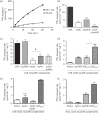The FupA/B protein uniquely facilitates transport of ferrous iron and siderophore-associated ferric iron across the outer membrane of Francisella tularensis live vaccine strain
- PMID: 24307666
- PMCID: PMC3919536
- DOI: 10.1099/mic.0.072835-0
The FupA/B protein uniquely facilitates transport of ferrous iron and siderophore-associated ferric iron across the outer membrane of Francisella tularensis live vaccine strain
Abstract
Francisella tularensis is a highly infectious Gram-negative pathogen that replicates intracellularly within the mammalian host. One of the factors associated with virulence of F. tularensis is the protein FupA that mediates high-affinity transport of ferrous iron across the outer membrane. Together with its paralogue FslE, a siderophore-ferric iron transporter, FupA supports survival of the pathogen in the host by providing access to the essential nutrient iron. The FupA orthologue in the attenuated live vaccine strain (LVS) is encoded by the hybrid gene fupA/B, the product of an intergenic recombination event that significantly contributes to attenuation of the strain. We used (55)Fe transport assays with mutant strains complemented with the different paralogues to show that the FupA/B protein of LVS retains the capacity for high-affinity transport of ferrous iron, albeit less efficiently than FupA of virulent strain Schu S4. (55)Fe transport assays using purified siderophore and siderophore-dependent growth assays on iron-limiting agar confirmed previous findings that FupA/B also contributes to siderophore-mediated ferric iron uptake. These assays further demonstrated that the LVS FslE protein is a weaker siderophore-ferric iron transporter than the orthologue from Schu S4, and may be a result of the sequence variation between the two proteins. Our results indicate that iron-uptake mechanisms in LVS differ from those in Schu S4 and that functional differences in the outer membrane iron transporters have distinct effects on growth under iron limitation.
Figures








Similar articles
-
The fslE homolog, FTL_0439 (fupA/B), mediates siderophore-dependent iron uptake in Francisella tularensis LVS.Infect Immun. 2010 Oct;78(10):4276-85. doi: 10.1128/IAI.00503-10. Epub 2010 Aug 9. Infect Immun. 2010. PMID: 20696823 Free PMC article.
-
Paralogous outer membrane proteins mediate uptake of different forms of iron and synergistically govern virulence in Francisella tularensis tularensis.J Biol Chem. 2012 Jul 20;287(30):25191-202. doi: 10.1074/jbc.M112.371856. Epub 2012 Jun 1. J Biol Chem. 2012. PMID: 22661710 Free PMC article.
-
Two parallel pathways for ferric and ferrous iron acquisition support growth and virulence of the intracellular pathogen Francisella tularensis Schu S4.Microbiologyopen. 2016 Jun;5(3):453-68. doi: 10.1002/mbo3.342. Epub 2016 Feb 25. Microbiologyopen. 2016. PMID: 26918301 Free PMC article.
-
Iron and Virulence in Francisella tularensis.Front Cell Infect Microbiol. 2017 Apr 4;7:107. doi: 10.3389/fcimb.2017.00107. eCollection 2017. Front Cell Infect Microbiol. 2017. PMID: 28421167 Free PMC article. Review.
-
Fate of ferrisiderophores after import across bacterial outer membranes: different iron release strategies are observed in the cytoplasm or periplasm depending on the siderophore pathways.Amino Acids. 2013 May;44(5):1267-77. doi: 10.1007/s00726-013-1468-2. Epub 2013 Feb 27. Amino Acids. 2013. PMID: 23443998 Review.
Cited by
-
Francisella tularensis: FupA mutation contributes to fluoroquinolone resistance by increasing vesicle secretion and biofilm formation.Emerg Microbes Infect. 2019;8(1):808-822. doi: 10.1080/22221751.2019.1615848. Emerg Microbes Infect. 2019. PMID: 31164053 Free PMC article.
-
Intracellular Experimental Evolution of Francisella tularensis Subsp. holarctica Live Vaccine Strain (LVS) to Antimicrobial Resistance.ACS Infect Dis. 2023 Feb 10;9(2):308-321. doi: 10.1021/acsinfecdis.2c00483. Epub 2023 Jan 20. ACS Infect Dis. 2023. PMID: 36662533 Free PMC article.
-
The Ability to Acquire Iron Is Inversely Related to Virulence and the Protective Efficacy of Francisella tularensis Live Vaccine Strain.Front Microbiol. 2018 Apr 4;9:607. doi: 10.3389/fmicb.2018.00607. eCollection 2018. Front Microbiol. 2018. PMID: 29670588 Free PMC article.
-
The reduced genome of the Francisella tularensis live vaccine strain (LVS) encodes two iron acquisition systems essential for optimal growth and virulence.PLoS One. 2014 Apr 2;9(4):e93558. doi: 10.1371/journal.pone.0093558. eCollection 2014. PLoS One. 2014. PMID: 24695402 Free PMC article.
-
Mutational Switch-Backs Can Accelerate Evolution of Francisella to a Combination of Ciprofloxacin and Doxycycline.Front Microbiol. 2022 May 9;13:904822. doi: 10.3389/fmicb.2022.904822. eCollection 2022. Front Microbiol. 2022. PMID: 35615518 Free PMC article.
References
-
- Broekhuijsen M., Larsson P., Johansson A., Byström M., Eriksson U., Larsson E., Prior R. G., Sjöstedt A., Titball R. W., Forsman M. (2003). Genome-wide DNA microarray analysis of Francisella tularensis strains demonstrates extensive genetic conservation within the species but identifies regions that are unique to the highly virulent F. tularensis subsp. tularensis. J Clin Microbiol 41, 2924–2931. 10.1128/JCM.41.7.2924-2931.2003 - DOI - PMC - PubMed
Publication types
MeSH terms
Substances
Grants and funding
LinkOut - more resources
Full Text Sources
Other Literature Sources
Medical

